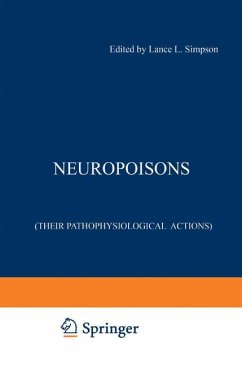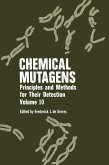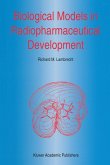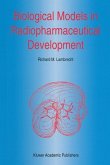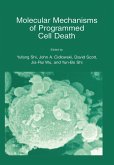Neuropoisons
Their Pathophysiological Actions
Herausgegeben:Simpson, Lance L.
Neuropoisons
Their Pathophysiological Actions
Herausgegeben:Simpson, Lance L.
- Broschiertes Buch
- Merkliste
- Auf die Merkliste
- Bewerten Bewerten
- Teilen
- Produkt teilen
- Produkterinnerung
- Produkterinnerung
Poisons are topics of multidisciplinary concern. The clinician and the pathologist are sensitive to instances of human poisoning. The laboratory researcher, whether pharmacologist, physiologist, or biochemist, is oriented toward molecular modes of poison action. Both clinician and researcher are eager to learn of poisons that can be used as therapeutic agents or methodological tools. This volume is an attempt to underscore the multidisciplinary charac ter of neuropoisons. Six poisons of animal origin which are receiving considerable clinical and research attention are discussed. Each poison is…mehr
Andere Kunden interessierten sich auch für
![Latent Herpes Virus Infections in Veterinary Medicine Latent Herpes Virus Infections in Veterinary Medicine]() Latent Herpes Virus Infections in Veterinary Medicine42,99 €
Latent Herpes Virus Infections in Veterinary Medicine42,99 €![Chemical Mutagens Chemical Mutagens]() Alexander Hollaender / Frederick J. de Serres (eds.)Chemical Mutagens112,99 €
Alexander Hollaender / Frederick J. de Serres (eds.)Chemical Mutagens112,99 €![Biological Models in Radiopharmaceutical Development Biological Models in Radiopharmaceutical Development]() R. M. LambrechtBiological Models in Radiopharmaceutical Development113,99 €
R. M. LambrechtBiological Models in Radiopharmaceutical Development113,99 €![Biological Models in Radiopharmaceutical Development Biological Models in Radiopharmaceutical Development]() R. M. LambrechtBiological Models in Radiopharmaceutical Development42,99 €
R. M. LambrechtBiological Models in Radiopharmaceutical Development42,99 €![Molecular Mechanisms of Programmed Cell Death Molecular Mechanisms of Programmed Cell Death]() Molecular Mechanisms of Programmed Cell Death125,99 €
Molecular Mechanisms of Programmed Cell Death125,99 €![Oxygen Radicals in the Pathophysiology of Heart Disease Oxygen Radicals in the Pathophysiology of Heart Disease]() Pawan K. Singal (ed.)Oxygen Radicals in the Pathophysiology of Heart Disease196,99 €
Pawan K. Singal (ed.)Oxygen Radicals in the Pathophysiology of Heart Disease196,99 €![Epidemiology and Control of Nematodiasis in Cattle Epidemiology and Control of Nematodiasis in Cattle]() Epidemiology and Control of Nematodiasis in Cattle42,99 €
Epidemiology and Control of Nematodiasis in Cattle42,99 €-
-
-
Poisons are topics of multidisciplinary concern. The clinician and the pathologist are sensitive to instances of human poisoning. The laboratory researcher, whether pharmacologist, physiologist, or biochemist, is oriented toward molecular modes of poison action. Both clinician and researcher are eager to learn of poisons that can be used as therapeutic agents or methodological tools. This volume is an attempt to underscore the multidisciplinary charac ter of neuropoisons. Six poisons of animal origin which are receiving considerable clinical and research attention are discussed. Each poison is presented first as a clinical entity, then as a topic of investigative research, and finally as an agent useful to the study of nerve function. Because no single volume on neuropoisons can be exhaustive, an attempt at balance is offered as compensation. Two snake venoms, two marine poisons, and two bacterial toxins are presented in detail. In the sequel to this volume, attention will be focused on representative neuro poisons of plant origin.
Produktdetails
- Produktdetails
- Verlag: Springer / Springer US / Springer, Berlin
- Artikelnr. des Verlages: 978-1-4684-2942-8
- 1971
- Seitenzahl: 380
- Erscheinungstermin: 17. März 2012
- Englisch
- Abmessung: 229mm x 152mm x 21mm
- Gewicht: 550g
- ISBN-13: 9781468429428
- ISBN-10: 1468429426
- Artikelnr.: 39502829
- Herstellerkennzeichnung Die Herstellerinformationen sind derzeit nicht verfügbar.
- Verlag: Springer / Springer US / Springer, Berlin
- Artikelnr. des Verlages: 978-1-4684-2942-8
- 1971
- Seitenzahl: 380
- Erscheinungstermin: 17. März 2012
- Englisch
- Abmessung: 229mm x 152mm x 21mm
- Gewicht: 550g
- ISBN-13: 9781468429428
- ISBN-10: 1468429426
- Artikelnr.: 39502829
- Herstellerkennzeichnung Die Herstellerinformationen sind derzeit nicht verfügbar.
1 Clinical Aspects of Elapid Bite.- I. Introduction.- II. Elapidae.- III. Symptomatology of Elapid Bite.- IV. Treatment.- V. References.- 2 Mode of Action of Cobra Venom and Its Purified Toxins.- I. Introduction.- II. Chemistry of Cobra Venom.- III. Pharmacological Actions of Cobra Venom.- IV. Concluding Remarks.- V. References.- 3 Symptomatology of Experimental and Clinical Crotalid Envenomation.- I. The Rattlesnake.- II. Rattlesnake Venom Potency.- III. Physiological Effects of Venom.- IV. Treatment of Snake Bite.- V. Concluding Remarks.- VI. References.- 4 The Mechanism of Snake Venom Actions-Rattlesnakes and Other Crotalids.- I. Introduction.- II. Action of Snake Venoms.- III. References.- 5 The Use of Snake Venoms as Pharmacological Tools in Studying Nerve Activity.- I. Introduction.- II. Development and Differentiation of the Nervous System.- III. Neuronal Degeneration and Demyelination.- IV. Axonal Conduction.- V. Membrane Permeability.- VI. Phospholipid Function in Nerve.- VII. Neuronal Metabolism.- VIII. Conclusions.- IX. References.- 6 Fugu (PufFer-Fish) Poisoning and the Pharmacology of Crystalline Tetrodotoxin in Poisoning.- I. Introduction.- II. Actual Conditions and Statistical Survey of Fugu Poisoning.- III. Clinical Symptoms and Treatment of Fugu Intoxication.- IV. Pharmacological Actions Underlying Clinical Symptons.- V. Legislative Control for Preventing Fugu Poisoning in Japan.- VI. Tested Clinical Use of Crystalline Tetrodotoxin.- VII. References.- 7 Paralytic Shellfish Poisoning and Saxitoxin.- I. Occurrence and Distribution of Paralytic Shellfish Poisoning.- II. Shellfish Poisoning as a Public Health Problem.- III. Detection of Shellfish Poisoning.- IV. Isolation and Characterization of Shellfish Poisons.- V. References.- 8 Mechanism of Action ofTetrodotoxin (TTX) and Saxitoxin (STX).- I. Introduction.- II. The Nature of the Nerve Impulse.- III. Cellular Actions of TTX and STX.- IV. Comparison of TTX and STX.- V. Mechanism of Action.- VI. Conclusion.- VII. References.- 9 Tetrodotoxin and Saxitoxin as Pharmacological Tools.- I. Introduction.- II. Cellular Effects.- III. Pharmacological Uses.- IV. Conclusion.- V. References.- 10 The Clinical Effects of Tetanus.- I. Tetanus: The World Problem.- II. Clinical Features.- III. The Natural History of Tetanus.- IV. Complications.- V. Causes of Death.- VI. Treatment.- VII. Prevention of Tetanus.- VIII. References.- 11 Biochemical and Physiological Aspects of Tetanus Intoxication.- I. Introduction.- II. The Toxin.- III. Biochemical Mechanisms Involved in Tetanus Intoxication.- IV. Effect of Environmental Temperature on Tetanus Intoxication.- V. Binding of Tetanus Toxin.- VI. Physiology of Tetanus Intoxication.- VII. Summary.- VIII. References.- 12 Tetanus Toxin as a Neuropharmacological Tool.- I. Introduction.- II. Techniques of Administration.- III. Tetanus Toxin and Central Inhibition.- IV. Tetanus Toxin and Cholinergic Transmission.- V. Mode of Action.- VI. Conclusion.- VII. References.- 13 The Clinical Aspects of Botulism.- I. History.- II. Botulism as a World Health Problem.- III. Epidemiologic Considerations.- IV. Pathogenesis.- V. Clinical Features of Botulism.- VI. Diagnosis.- VII. Treatment.- VIII. Prognosis and Recovery.- IX. Remaining Problems.- X. References.- 14 The Neuroparalytic and Hemagglutinating Activities of Botulinum Toxin.- I. Introduction.- II. Characterization of the Botulinum Toxin Molecule.- III. Botulinum Hemagglutinin.- IV. Target Organs of Botulinum Neurotoxin.- V. Mechanism of Neurotoxin Action.- VI. Reactive Sites Involved in Neurotoxin Activity.- VII. Conclusion.- VIII. References.- 15 Botulinum Toxin as a Tool for Research on the Nervous System.- I. Introduction.- II. Neuromuscular Transmission.- III. Botulinum Toxin as a Pharmacological Tool.- IV. The "Trophic" Effects of Nerves.- V. Botulinum Toxin and the Autonomic Nervous System.- VI. Botulinum Toxin as a Marker of Cholinergic Synapses: A Possible Future Use.- VII. The Role of Movement in the Development of Joints: A Model System.- VIII. References.- IX. Appendix.
1 Clinical Aspects of Elapid Bite.- I. Introduction.- II. Elapidae.- III. Symptomatology of Elapid Bite.- IV. Treatment.- V. References.- 2 Mode of Action of Cobra Venom and Its Purified Toxins.- I. Introduction.- II. Chemistry of Cobra Venom.- III. Pharmacological Actions of Cobra Venom.- IV. Concluding Remarks.- V. References.- 3 Symptomatology of Experimental and Clinical Crotalid Envenomation.- I. The Rattlesnake.- II. Rattlesnake Venom Potency.- III. Physiological Effects of Venom.- IV. Treatment of Snake Bite.- V. Concluding Remarks.- VI. References.- 4 The Mechanism of Snake Venom Actions-Rattlesnakes and Other Crotalids.- I. Introduction.- II. Action of Snake Venoms.- III. References.- 5 The Use of Snake Venoms as Pharmacological Tools in Studying Nerve Activity.- I. Introduction.- II. Development and Differentiation of the Nervous System.- III. Neuronal Degeneration and Demyelination.- IV. Axonal Conduction.- V. Membrane Permeability.- VI. Phospholipid Function in Nerve.- VII. Neuronal Metabolism.- VIII. Conclusions.- IX. References.- 6 Fugu (PufFer-Fish) Poisoning and the Pharmacology of Crystalline Tetrodotoxin in Poisoning.- I. Introduction.- II. Actual Conditions and Statistical Survey of Fugu Poisoning.- III. Clinical Symptoms and Treatment of Fugu Intoxication.- IV. Pharmacological Actions Underlying Clinical Symptons.- V. Legislative Control for Preventing Fugu Poisoning in Japan.- VI. Tested Clinical Use of Crystalline Tetrodotoxin.- VII. References.- 7 Paralytic Shellfish Poisoning and Saxitoxin.- I. Occurrence and Distribution of Paralytic Shellfish Poisoning.- II. Shellfish Poisoning as a Public Health Problem.- III. Detection of Shellfish Poisoning.- IV. Isolation and Characterization of Shellfish Poisons.- V. References.- 8 Mechanism of Action ofTetrodotoxin (TTX) and Saxitoxin (STX).- I. Introduction.- II. The Nature of the Nerve Impulse.- III. Cellular Actions of TTX and STX.- IV. Comparison of TTX and STX.- V. Mechanism of Action.- VI. Conclusion.- VII. References.- 9 Tetrodotoxin and Saxitoxin as Pharmacological Tools.- I. Introduction.- II. Cellular Effects.- III. Pharmacological Uses.- IV. Conclusion.- V. References.- 10 The Clinical Effects of Tetanus.- I. Tetanus: The World Problem.- II. Clinical Features.- III. The Natural History of Tetanus.- IV. Complications.- V. Causes of Death.- VI. Treatment.- VII. Prevention of Tetanus.- VIII. References.- 11 Biochemical and Physiological Aspects of Tetanus Intoxication.- I. Introduction.- II. The Toxin.- III. Biochemical Mechanisms Involved in Tetanus Intoxication.- IV. Effect of Environmental Temperature on Tetanus Intoxication.- V. Binding of Tetanus Toxin.- VI. Physiology of Tetanus Intoxication.- VII. Summary.- VIII. References.- 12 Tetanus Toxin as a Neuropharmacological Tool.- I. Introduction.- II. Techniques of Administration.- III. Tetanus Toxin and Central Inhibition.- IV. Tetanus Toxin and Cholinergic Transmission.- V. Mode of Action.- VI. Conclusion.- VII. References.- 13 The Clinical Aspects of Botulism.- I. History.- II. Botulism as a World Health Problem.- III. Epidemiologic Considerations.- IV. Pathogenesis.- V. Clinical Features of Botulism.- VI. Diagnosis.- VII. Treatment.- VIII. Prognosis and Recovery.- IX. Remaining Problems.- X. References.- 14 The Neuroparalytic and Hemagglutinating Activities of Botulinum Toxin.- I. Introduction.- II. Characterization of the Botulinum Toxin Molecule.- III. Botulinum Hemagglutinin.- IV. Target Organs of Botulinum Neurotoxin.- V. Mechanism of Neurotoxin Action.- VI. Reactive Sites Involved in Neurotoxin Activity.- VII. Conclusion.- VIII. References.- 15 Botulinum Toxin as a Tool for Research on the Nervous System.- I. Introduction.- II. Neuromuscular Transmission.- III. Botulinum Toxin as a Pharmacological Tool.- IV. The "Trophic" Effects of Nerves.- V. Botulinum Toxin and the Autonomic Nervous System.- VI. Botulinum Toxin as a Marker of Cholinergic Synapses: A Possible Future Use.- VII. The Role of Movement in the Development of Joints: A Model System.- VIII. References.- IX. Appendix.

